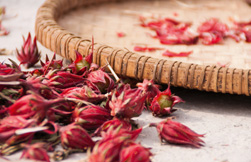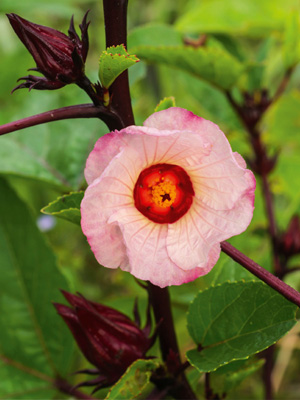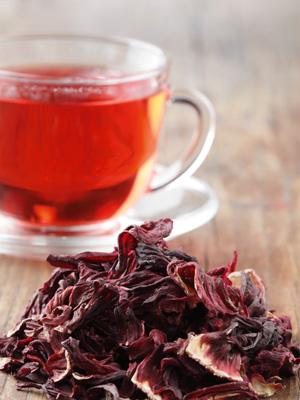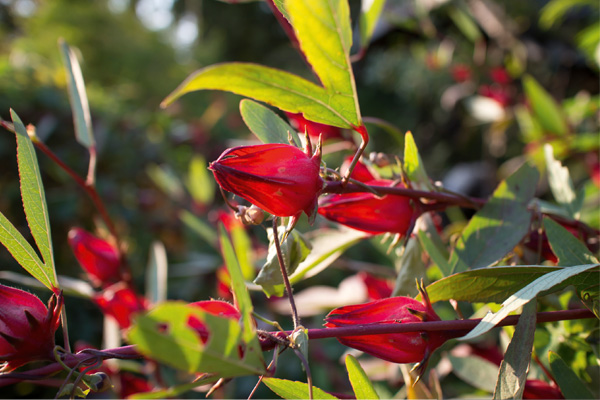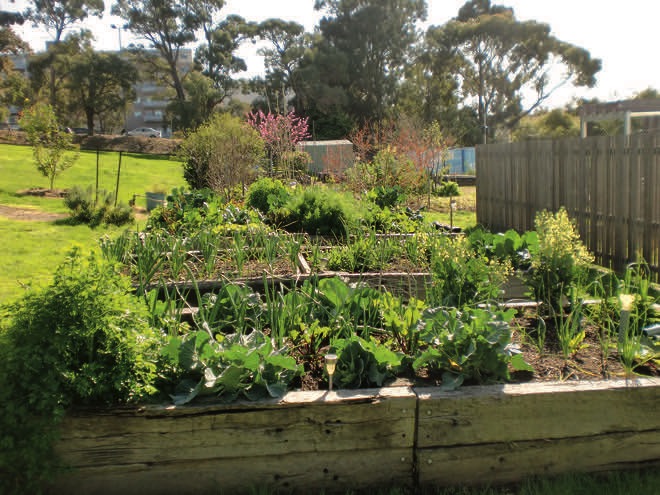Known also as rosella and often used in Australia for making jam, Hibiscus sabdariffa has many well-documented therapeutic powers
Apart from its usefulness for jam-making or prettying up a glass of bubbly, the main reason for growing Hibiscus sabdariffa is for its cardiovascular benefits. Let’s face it, you wouldn’t choose it for its rather plain-Jane looks — unlike its more beautiful ornamental cousins whose very appearance says tropical paradise.
Still, cardiovascular health is a very strong selling point. Many of us see a creeping rise in blood pressure and cholesterol levels as we age, but have no desire to go on medication. It’s far preferable to try to control these things naturally with diet and exercise.
It seems that a tisane (herbal tea) made from the calyces (sepals) of Hibiscus sabdariffa flowers can match the effectiveness of some blood-pressure medications, decreasing systolic pressure by as much as 11 per cent. Note that the studies demonstrating this effect have been on subjects with mild or pre-hypertension — not high enough to be on medication. Serious hypertension is another matter and definitely not something to try to manage on your own.
It’s not only scientific trials that offer positive assessments of the benefits of hibiscus tea, or sour tea as it’s also known due to its tart, cranberry-like flavour. It has been traditionally used to control blood pressure in many countries, from Africa and the Middle East to the Caribbean, Asia and the Philippines. It has a dizzying array of names to reflect this, including our own “rosella”, as well as nicknames like “drink of the gods” and “tisane of the pharaohs”.
Getting back to the scientific trials, studies on animals have consistently shown that consumption of an extract from this plant lowers blood pressure in a dose-dependent manner. Now studies on humans have shown similar results.
A 2009 study compared the antihypertensive effectiveness of hibiscus tea with that of black tea in 60 type 2 diabetic people with mild hypertension. It was found that the hibiscus tea was as effective at lowering blood pressure as the commonly used medication captopril — but with no side-effects.
Similarly, a 2010 randomised, double-blind, placebo-controlled trial involved 65 pre- and mildly hypertensive adults not on medication, who were allocated either three cups of hibiscus tea daily or placebo for six weeks. The results showed that the tea significantly lowered both systolic and diastolic blood pressure.
More than half the studies of the plant’s effect on lipid profiles have shown that the tea lowers total cholesterol, LDL (“bad”) cholesterol and triglycerides, while increasing HDL (“good”) cholesterol.
Scientists have looked at a number of mechanisms to explain these effects, including its kidney-protective effects, its mild diuretic action without impacting on electrolyte levels and its tendency to reduce sodium concentrations without affecting potassium levels.
Perhaps the most important factor is the antioxidant effects of the anthocyanins and the organic acids, including citric, malic and tartaric, which give it its sour taste. It also contains acidic polysaccharides and flavonoid glycosides that give it its characteristic deep-red colour.
The important rider to this is if you want to enjoy its therapeutic effects you need to consume it every day. Some of the studies mentioned showed that when participants stopped drinking the tea for just three days, their blood pressure began to creep upward — systolic pressure by 7.9 per cent and diastolic by 5.6 per cent.
Once you develop a taste for this delicious tea — made even more flavoursome by the addition of fresh ginger and a piece of cinnamon stick — you’ll find drinking it daily no hardship. While it is an ingredient in some herbal teas, most notably Red Zinger, often along with rosehips, pure hibiscus tea is very expensive to buy, so it’s well worth growing your own.
Growing
A West African native, Hibiscus sabdariffa is widely naturalised in northern Australia, including southeast Queensland — so much so that it’s regarded as an environmental weed in WA and NT. It likes warm climates and rich, well-drained soils. A perennial that’s usually grown as an annual (the first crop is its best), it can reach 1.5–2m in height but will need plenty of water and full sun for most of the day.
The plant needs a long growing season to crop — at least five months — so plant in spring when the soil is starting to warm up; late spring in southern areas; and early spring in tropical regions. The seed can be sown direct if the soil is warm enough, or plant out seedlings when they have four or five leaves.
Cover seed with 12mm of soil and plant 50cm apart. Use a pinch of fertiliser when planting in the ground and water in with a Seasol solution or similar. Three or four plants should give a good crop of calyces for tea-making.
During summer, the plant produces dark-red-centred yellow or white flowers that turn pink over the day, followed by red fruit. The papery flower petals give way to a fleshy, bright red calyx (sepal) encasing the seed pod. This is the part we harvest, about 10 days after flowering, when red and fleshy. If left too long it will go dry and brown.
The plant has few problems though it can be attacked by hibiscus beetle and metallic flea beetle. Control with a soap spray.
Originally in Good Organic Gardening, Volume 5, No. 4
